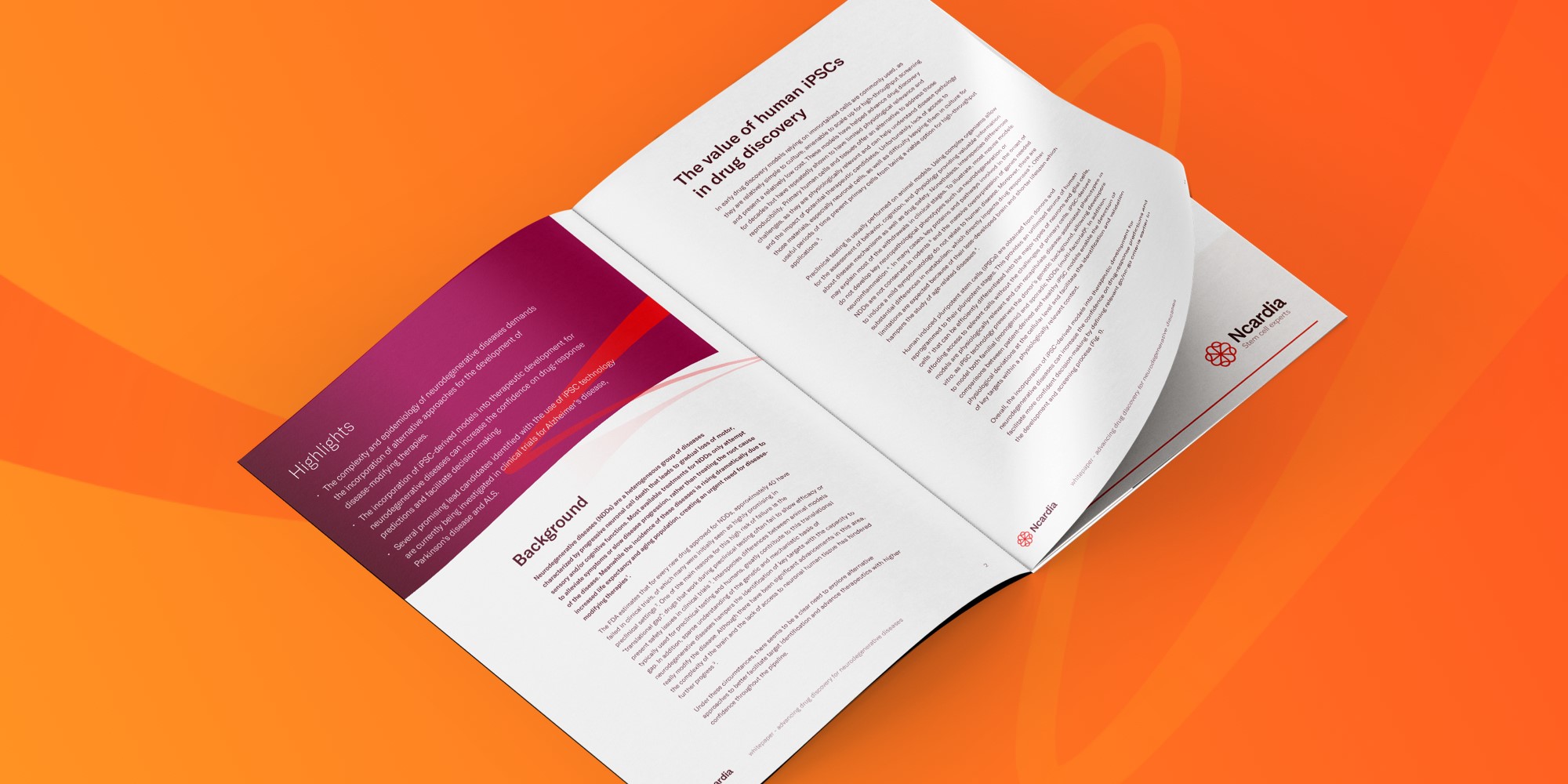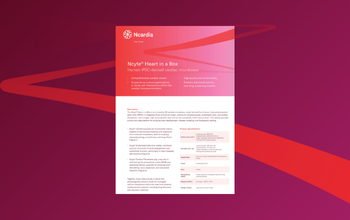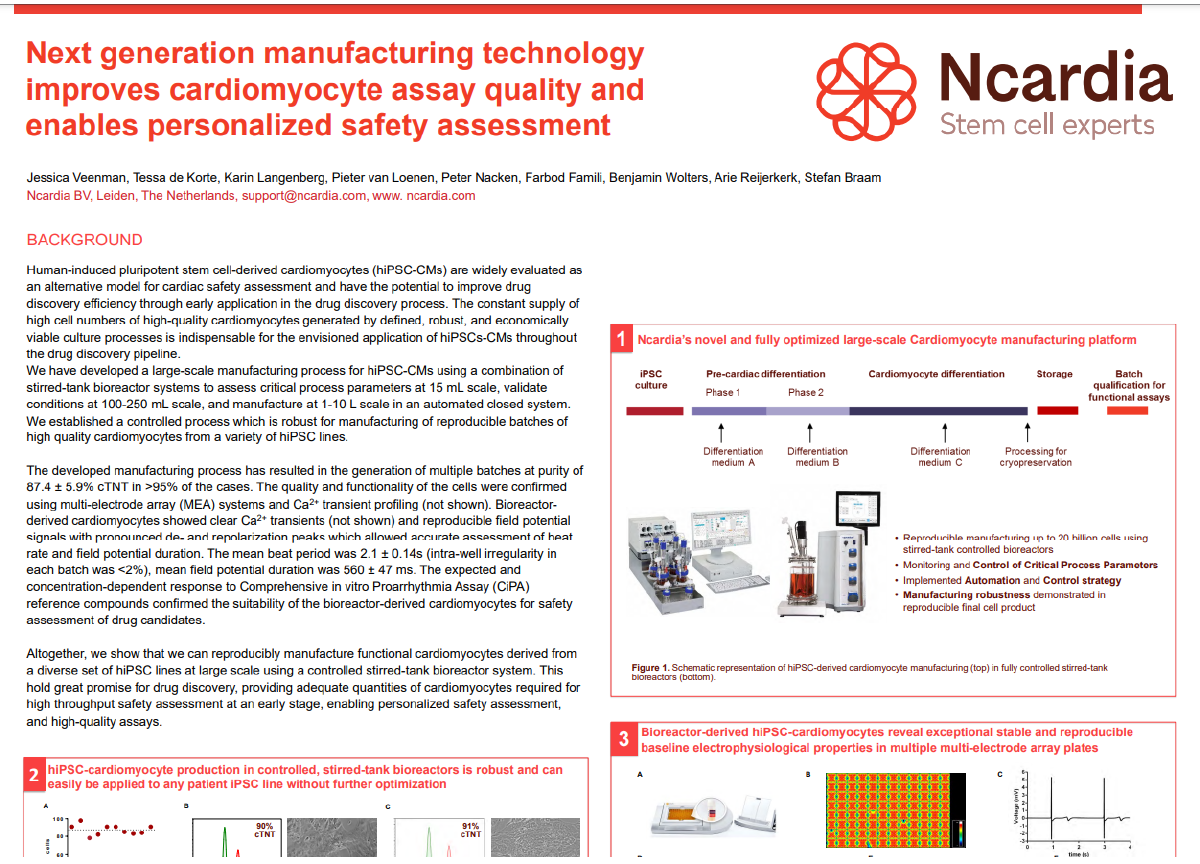Ncyte® vCardiomyocytes
Human iPSC-derived ventricular cardiomyocytes
Ventricular cardiomyocytes generated with our standardized process are fully functional. Their relatively slow beat rate enables pacing for electrophysiological research. Base on this model, an array of functional assays can be developed and optimized providing relevant predictions of drug-induced responses.
Our team can generate cardiomyocytes from the iPSC that best fits your project or work with off-the-shelf Ncyte® vCardiomyocytes to support your projects.
- High purity ventricular-like cardiomyocytes
- Physiologically relevant
- Highly suitable for electrophysiological research
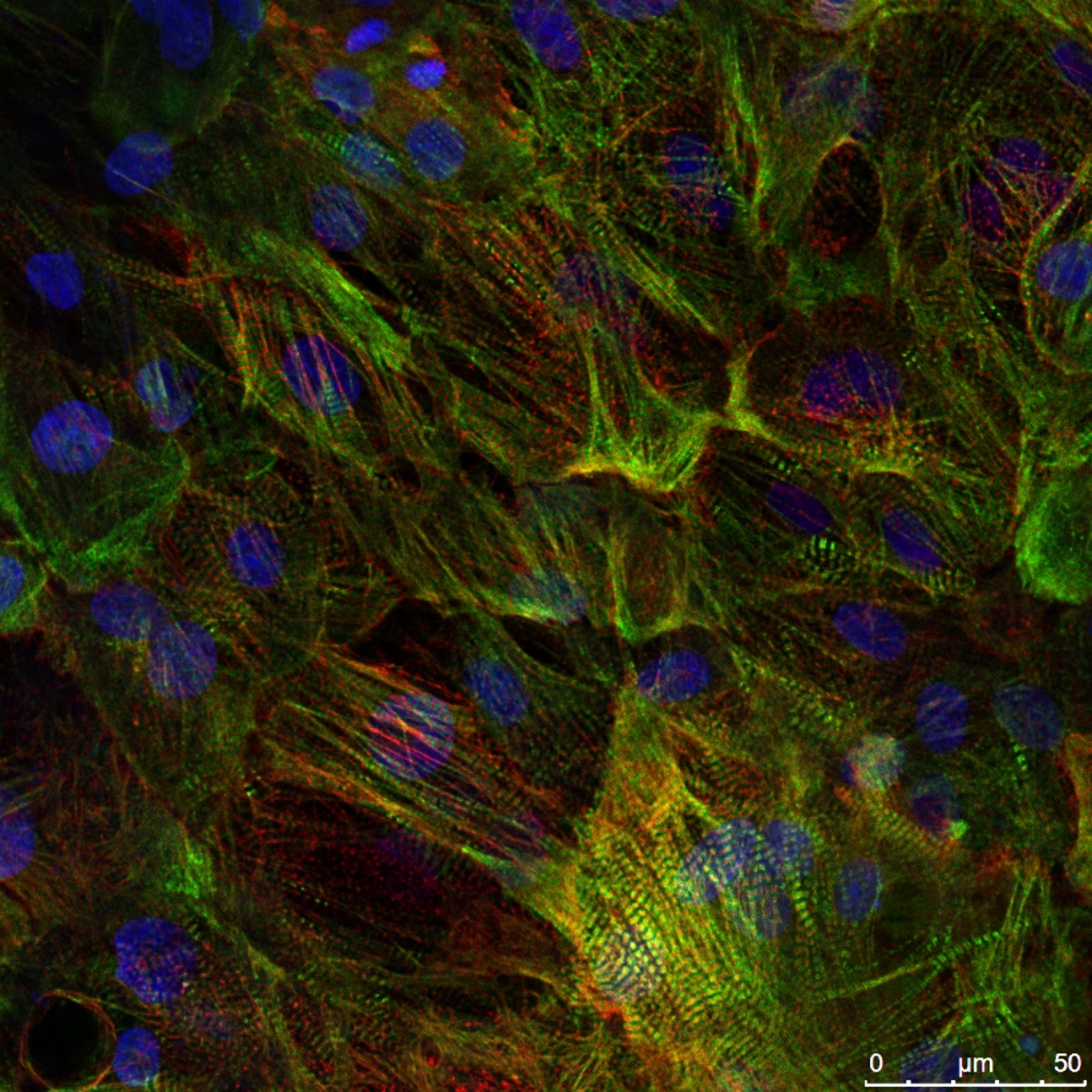
Do you want to buy Ncyte® vCardiomyocytes?
To proceed with your order, please review and accept our Terms and Conditions above.
Do you want to buy Ncyte® Cardiomyocyte Culture Medium?
To proceed with your order, please review and accept our Terms and Conditions above.
Do you need a larger volume or a custom cell model?
Product Specifications
Identity markers
≥ 90% TNNT2 at day 3 of culture according to user guide
Size
Two sizes available. ≥ 1M and ≥ 4M viable cells at day 3 of culture according to user guide
Quality Control
Cell count, Viability, Identity (FACS), Functionality (MEA - Dofetilide, Nifedipine, Isoproterenol), Mycoplasma
Format
Cryopreserved cells
Donor
Female
Reprogramming method
Non-viral
Shipping conditions
Dry shipper, -180°C to -135°C
Storage conditions
Vapor phase of liquid nitrogen
Supplied with
Ncyte® Cardiomyocyte Medium
Technical Data
Ncyte® vCardiomyocytes are characterized by flow cytometry to ensure a purity of ≥ 90% cardiac TroponinT (cTnT) positive cells after 3 days in culture following Ncardia’s user guide (Figure 2A). They typically express Myosin Light Chain 2v (MLC2v), indicating a ventricular-like phenotype (Figure 2B). Based on RNA-seq data, Ncyte® vCardiomyocytes express common sarcomere markers, such as TNNT2, while hiPSC and cardiac progenitor markers are silenced. Expression levels of additional genes are available upon request.
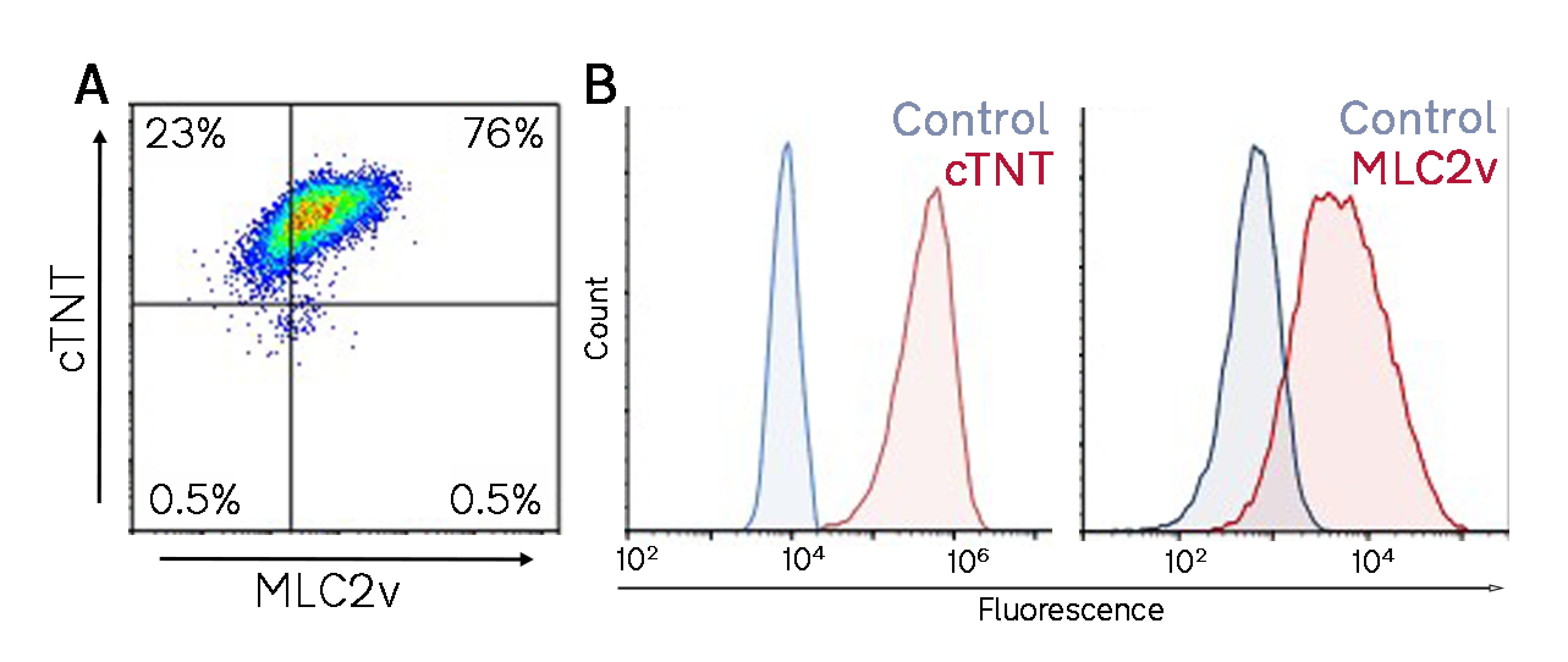 A) Flow cytometry analysis of one representative batch showing cTnT positive cells (99%) and cTnT/MLC2v double positive cells (76%). B) Histograms of cTNT and MLC2v fluorescence signal and their antibody controls.
A) Flow cytometry analysis of one representative batch showing cTnT positive cells (99%) and cTnT/MLC2v double positive cells (76%). B) Histograms of cTNT and MLC2v fluorescence signal and their antibody controls.
Ncyte® vCardiomyocytes exhibit well aligned myofibrils and intact structural sarcomere organization (See figure A). They typically express Myosin Light Chain 2v (MLC2v), indicating a ventricularlike phenotype. Based on RNA-seq data, Ncyte® vCardiomyocytes express common sarcomere markers, such as TNNT2, while hiPSC and cardiac progenitor markers are silenced. Expression levels of additional genes are available upon request.
Their action potential shows fast upstroke velocity and a well-defined plateau phase, resembling human ventricular cardiomyocytes (See figure B,C).
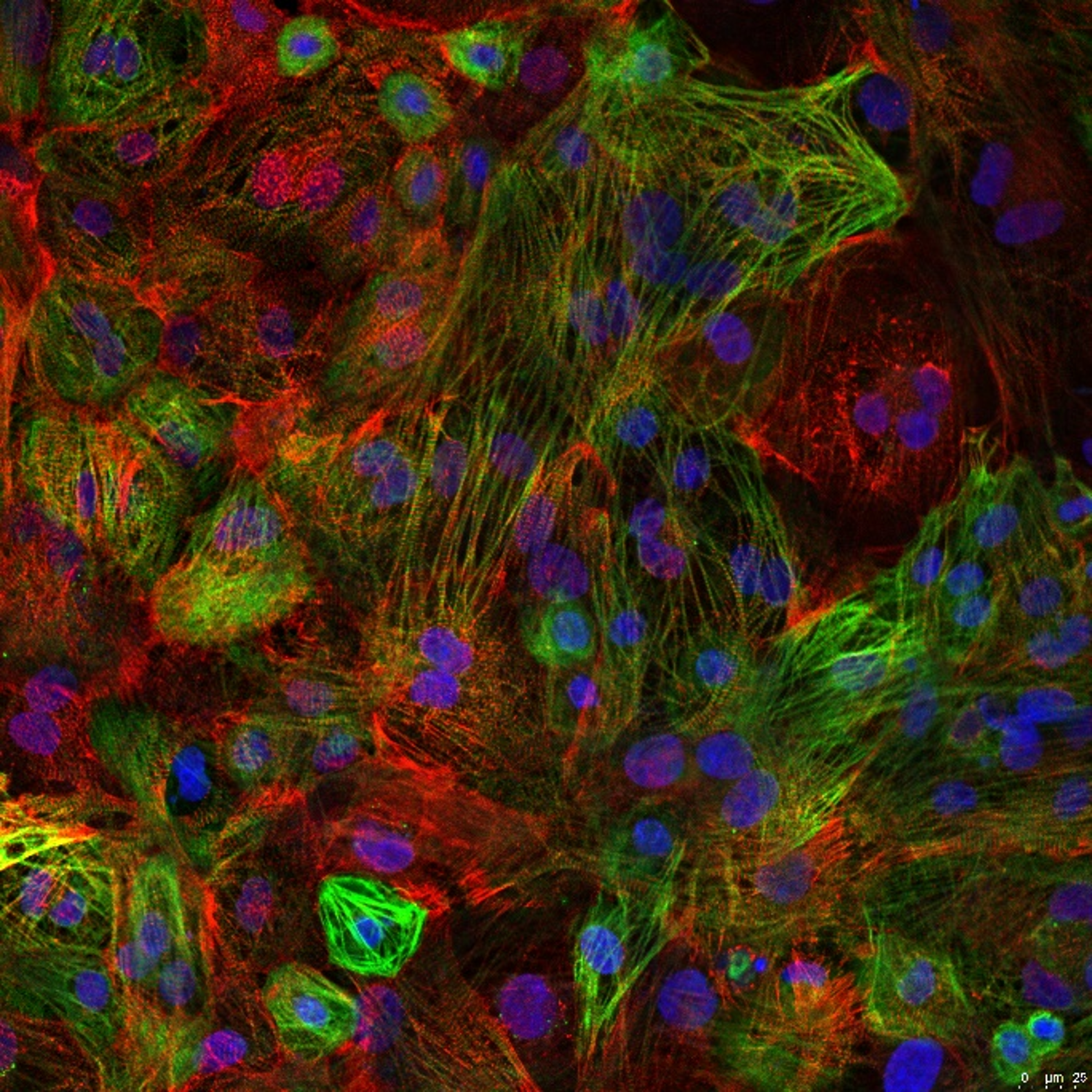 Immunofluorescence staining of Ncyte® vCardiomyocytes: Alpha-actinin (Red), myosin heavy-chain 6 (Green), and DAPI (Blue).
Immunofluorescence staining of Ncyte® vCardiomyocytes: Alpha-actinin (Red), myosin heavy-chain 6 (Green), and DAPI (Blue).
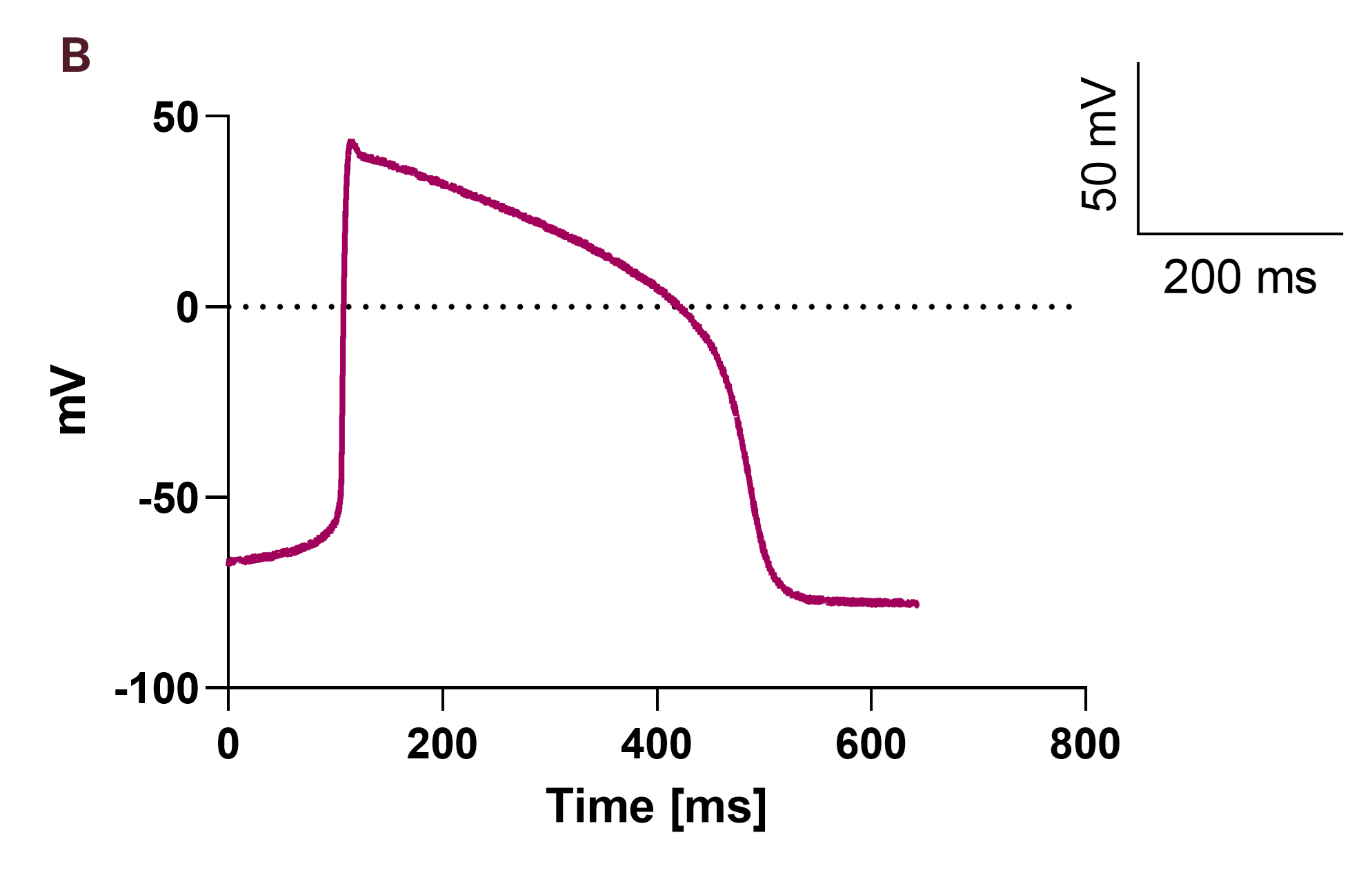 Representative patch-clamp action potential for a batch of Ncyte® vCardiomyocytes in current clamp mode.
Representative patch-clamp action potential for a batch of Ncyte® vCardiomyocytes in current clamp mode.
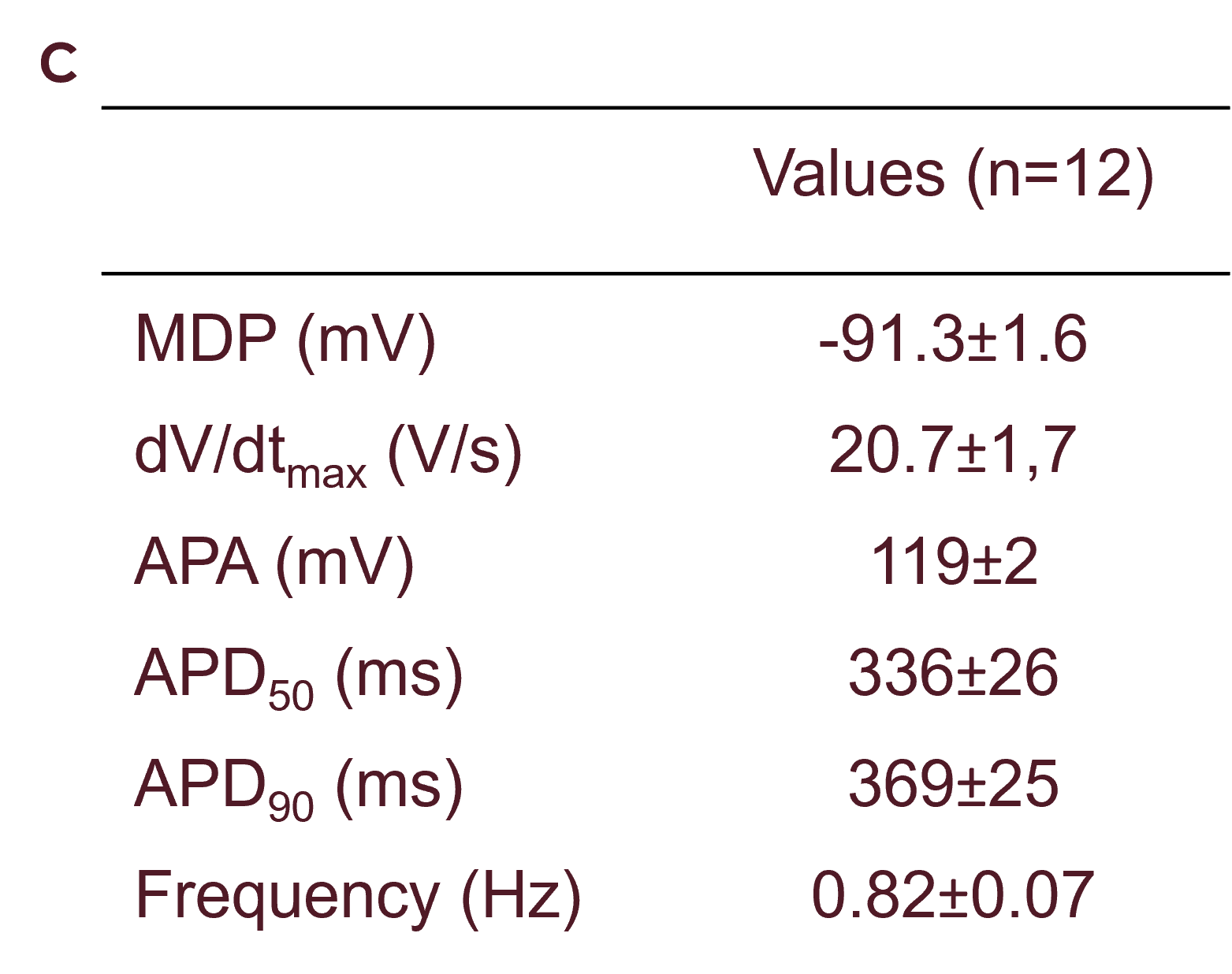 Table with averaged values of ventricular action potentials in current clamp mode. Data presented as mean ±SD (n = 12).
Table with averaged values of ventricular action potentials in current clamp mode. Data presented as mean ±SD (n = 12).
Ncyte® vCardiomyocytes present a relatively slow and uniform beating rate, which enables pacing for electrophysiological research.
Our scientific team is experienced in pharmacology and toxicity assays of cardiomyocytes to help you select the best drug candidates.
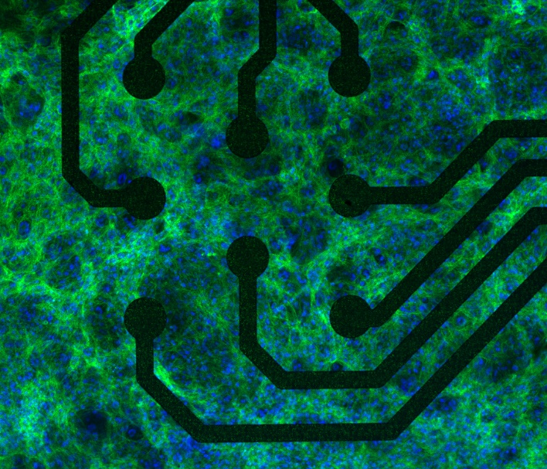 Immunofluorescence staining of Ncyte® vCardiomyocytes plated on a 96-well MEA plate: cTnT in green and DAPI in blue.
Immunofluorescence staining of Ncyte® vCardiomyocytes plated on a 96-well MEA plate: cTnT in green and DAPI in blue.
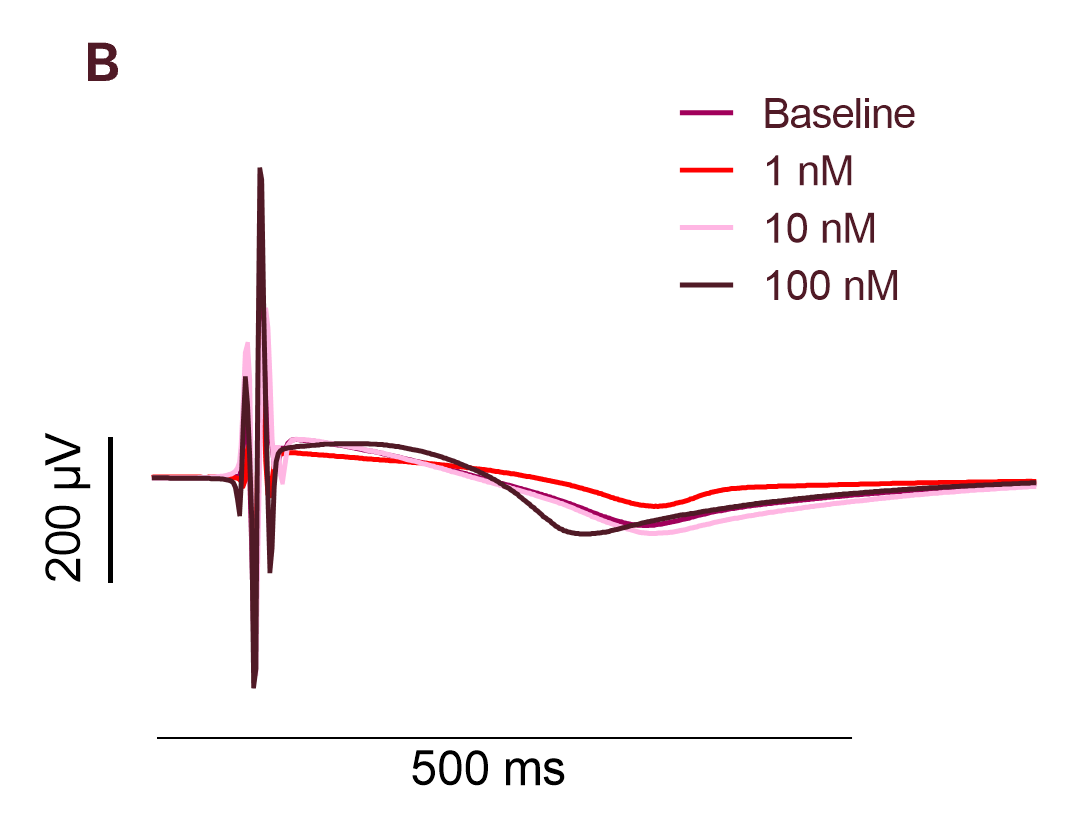 Representative MEA traces affter a 30 minute exposure to increased dosage of Isoproterenol.
Representative MEA traces affter a 30 minute exposure to increased dosage of Isoproterenol.
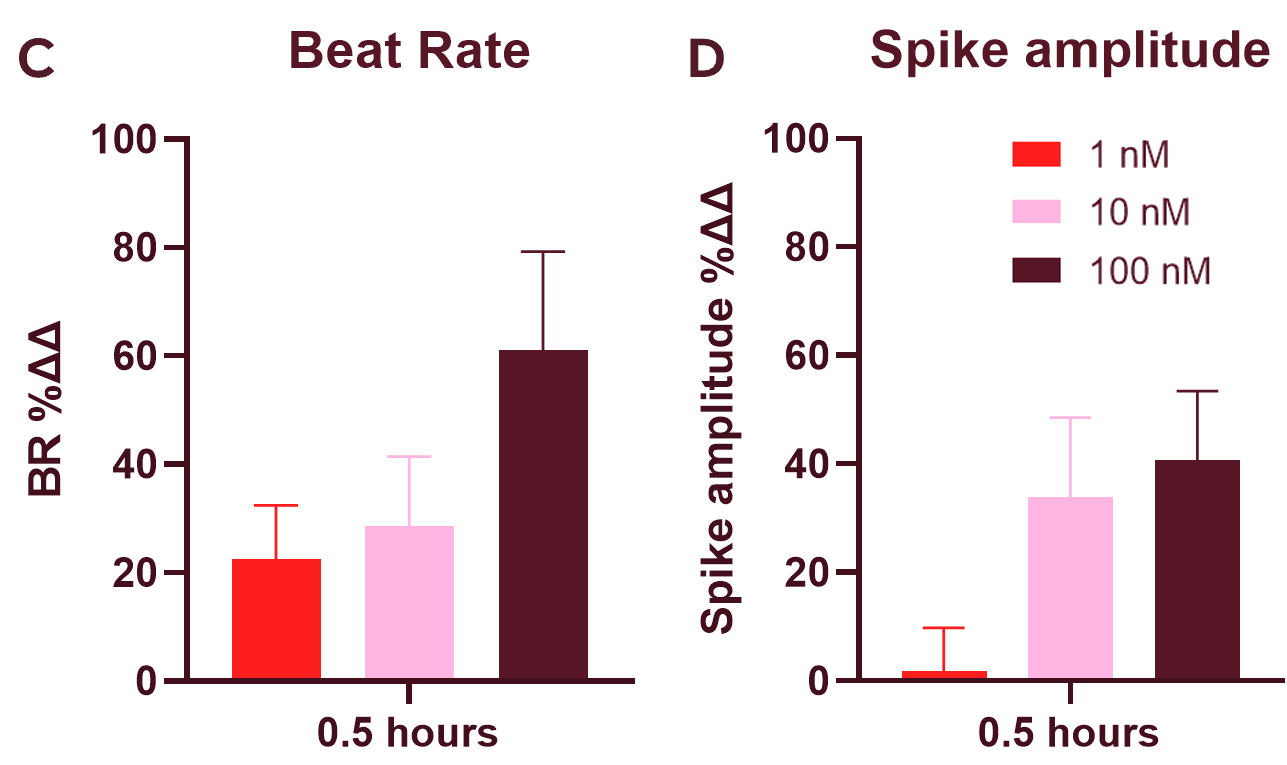 C) A 30-minute exposure to isoproterenol increased the beat rate and D) spike amplitude in Ncyte® vCardiomyocytes. Data presented as mean ±SD (n = 6) of the % change to baseline recordings for each well and time-matched 0.1% DMSO control.
C) A 30-minute exposure to isoproterenol increased the beat rate and D) spike amplitude in Ncyte® vCardiomyocytes. Data presented as mean ±SD (n = 6) of the % change to baseline recordings for each well and time-matched 0.1% DMSO control.
Response to adrenergic stimulation with isoproterenol and ion channel blockers, nifedipine (L-type calcium channel blocker) and dofetilide (hERG channel blocker), is guaranteed for every batch.
For more data download the fact sheet
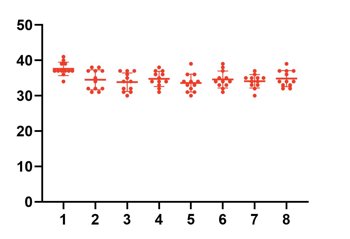 Microelectrode array baseline beating rate of a 96-well plate with Ncyte® vCardiomyocytes.
Microelectrode array baseline beating rate of a 96-well plate with Ncyte® vCardiomyocytes.
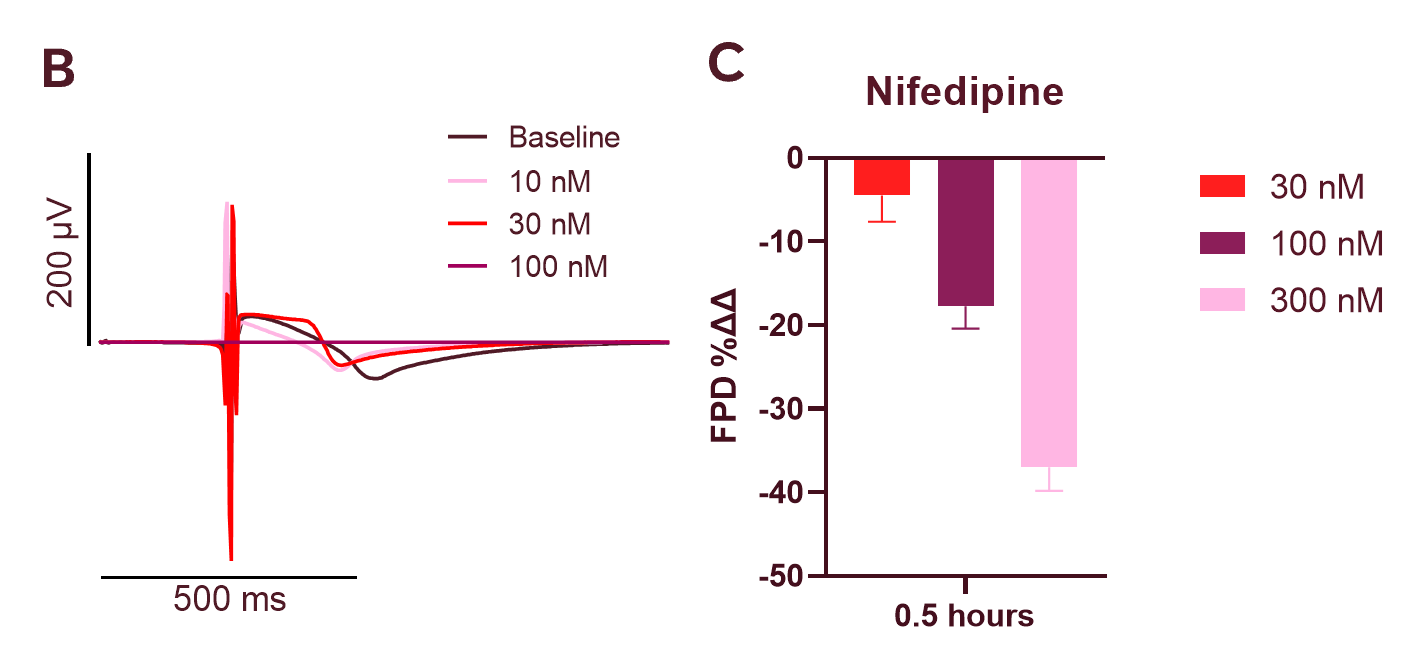 B) Representative MEA traces after a 30 minute exposure to increased dosage of Nifedipine. C) A 30-minute exposure to Nifedipine, an L-type calcium channel blocker, shortened the field potential duration of Ncyte® vCardiomyocytes in a dose dependent manner.
B) Representative MEA traces after a 30 minute exposure to increased dosage of Nifedipine. C) A 30-minute exposure to Nifedipine, an L-type calcium channel blocker, shortened the field potential duration of Ncyte® vCardiomyocytes in a dose dependent manner.
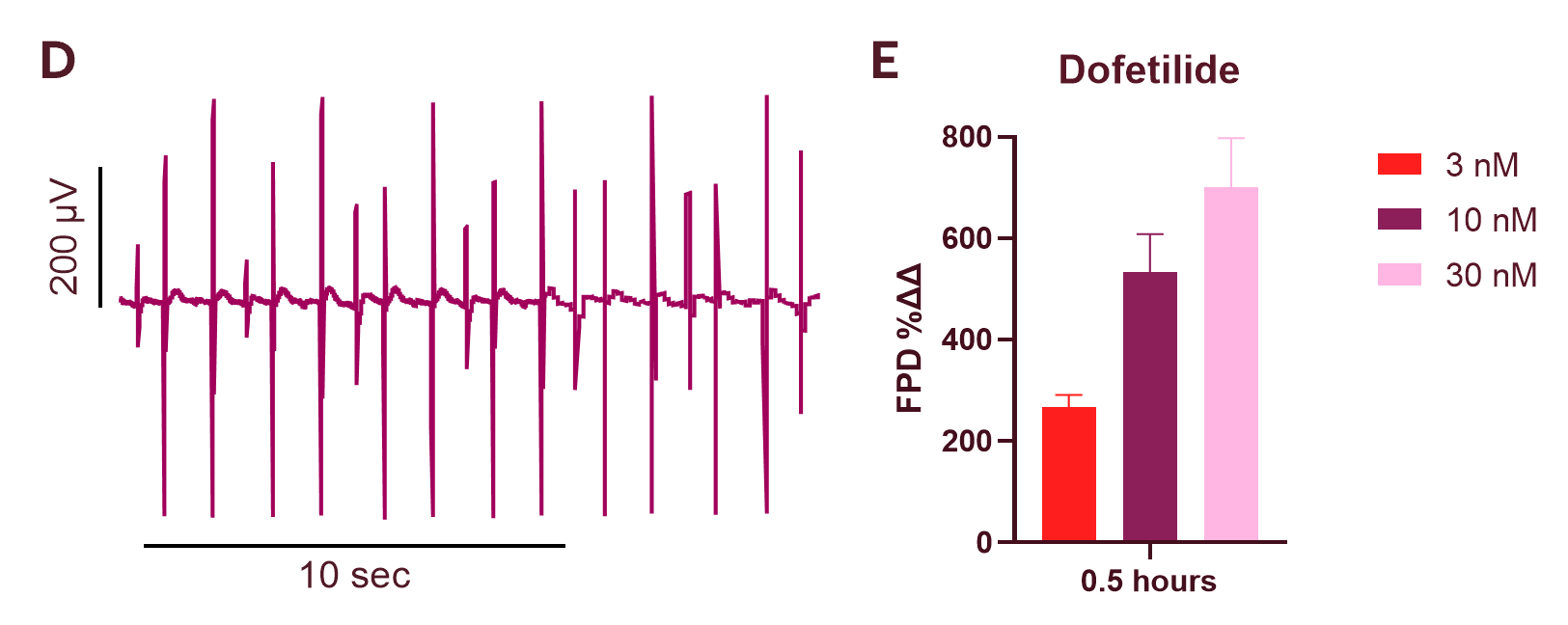 D) Representative trace after 30-minute exposure to dofetilide, a hERG (IKr) channel blocker at concentrations ≥10 nM, causes notable arrhythmias E) A 30-min exposure to Dofetilide induced a dose dependent prolongation of field potential duration in Ncyte® vCardiomyocytes. Data presented as mean ±SD (n = 6) of the % change to baseline recordings for each well and time-matched 0.1% DMSO control.
D) Representative trace after 30-minute exposure to dofetilide, a hERG (IKr) channel blocker at concentrations ≥10 nM, causes notable arrhythmias E) A 30-min exposure to Dofetilide induced a dose dependent prolongation of field potential duration in Ncyte® vCardiomyocytes. Data presented as mean ±SD (n = 6) of the % change to baseline recordings for each well and time-matched 0.1% DMSO control.
Certificates of analysis are available upon request via support@ncardia.com
Our work centers on a simple yet powerful premise:
When we combine deep iPSC knowledge, broad assay capabilities and a demonstrated ability to integrate the biology of human diseases into preclinical research, we can help drug developers make critical decisions earlier and with more confidence.
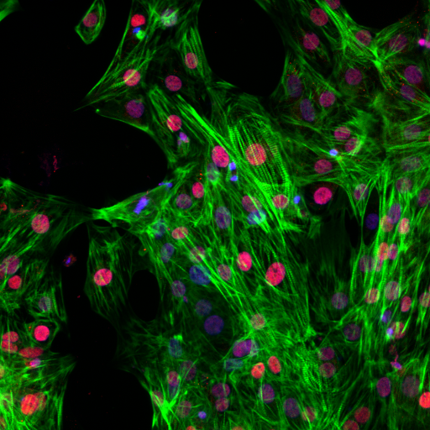
Human iPSC-derived atrial cardiomyocytes
Neural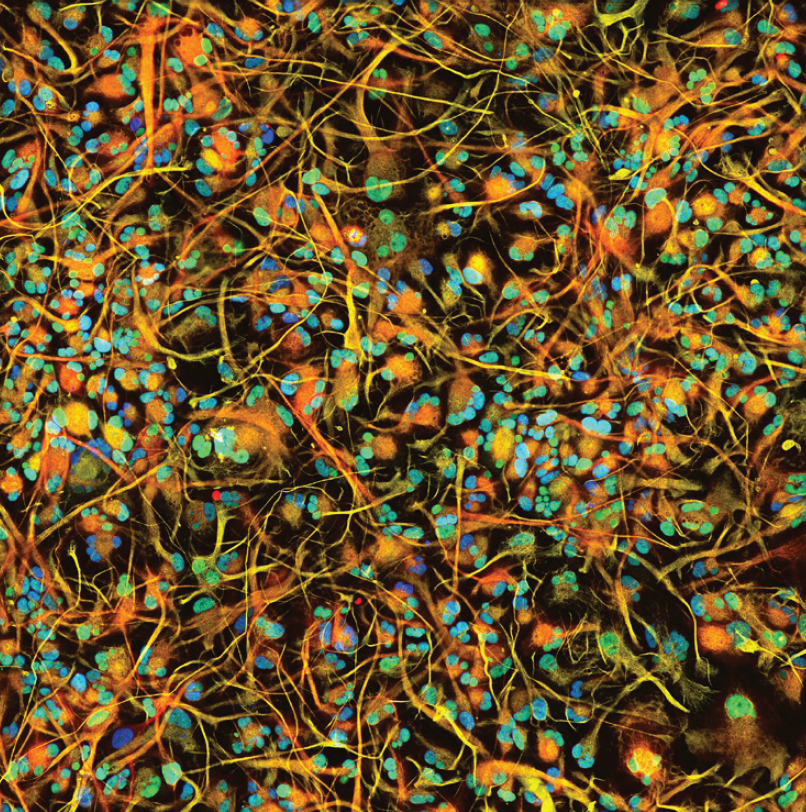
Human iPSC-derived astrocytes
Vascular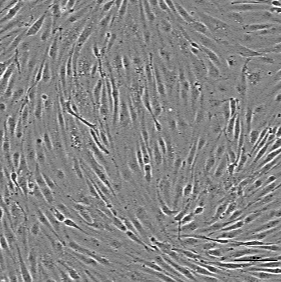
Human iPSC-derived vascular endothelial cells
Cardiac.png)
Human iPSC-derived 3D cardiac microtissue model
Neural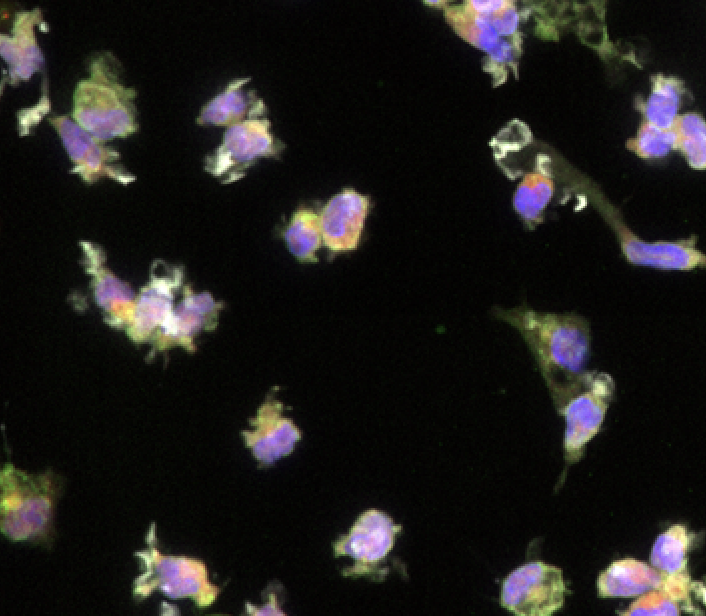
Human iPSC-derived microglia
Cardiac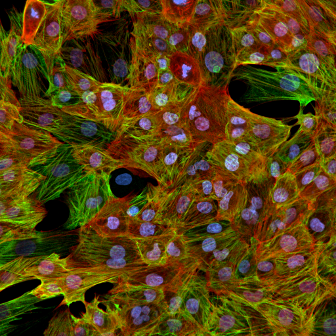
Non-Human Primate Cynomolgus iPSC-Derived Ventricular-Like Cardiomyocytes
Vascular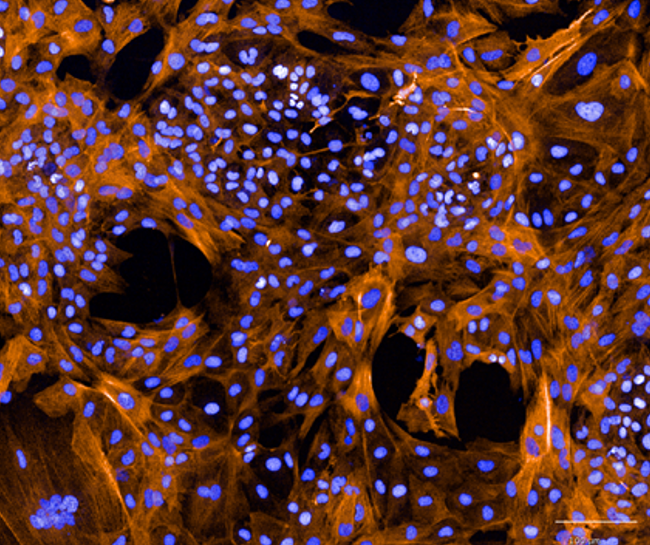
Human iPSC-derived vascular smooth muscle cells
Cardiac
Human iPSC-derived ventricular cardiomyocytes
